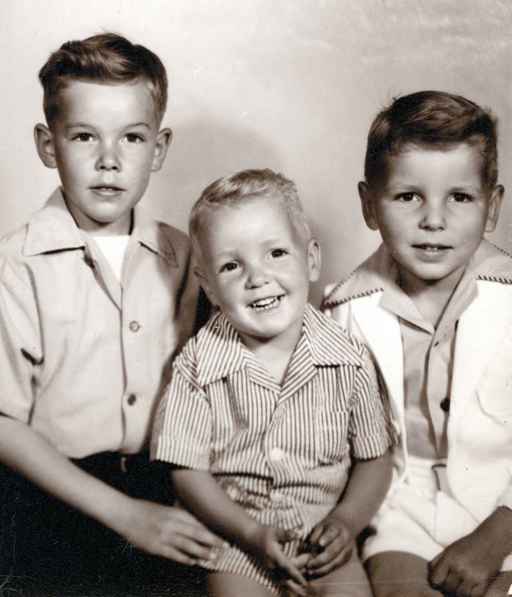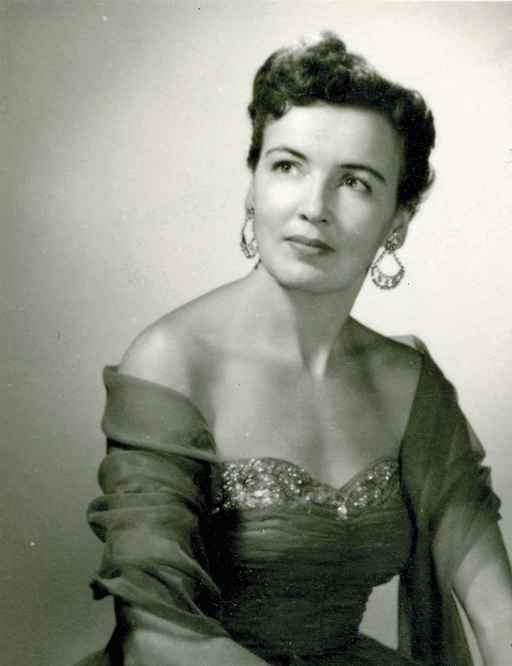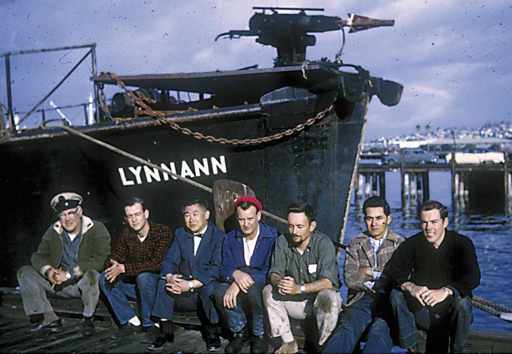War of the Whales (8 page)
Authors: Joshua Horwitz


Ken, on left, with half-brothers Howie and Rick Garrett, 1948.
When Ken was ten, Barbara married Cal Nelson, who moved the family to Sacramento, California. Cal had been a big game hunter, and their house was filled with exotic stuffed trophy heads. Cal took Ken duck hunting and taught him how to lead the bird and judge the trajectory of the buckshot. Cal and Barbara opened a dance hall/saloon they called the 1199 Club because it was 11 miles outside of Sacramento on Route 99. Barbara played the piano, Cal tended bar, and Ken and his half brothers got all the free hamburgers they could eat back in the kitchen. But Cal turned out to be more interested in drinking than in bartending. Barbara divorced her third husband the month the club closed, and Cal was dead a year later from cirrhosis of the liver.
Once Barbara became a single mother, freelancing as a piano player at Parisi’s Cocktail Lounge and the Palomino Club out on Route 50, Ken barely saw her at all. By the time he came home from school, she’ d be pulling on a cocktail dress and heading off to work. She wouldn’t return until well past midnight, and she’ d still be sleeping when Ken and his younger half brothers got themselves up and off to school.

Barbara Balcomb Bales, Ken’s mother, in her days as a piano bar singer.
There was no confusing Barbara with the other mothers of Sacramento. She was an attractive, slim brunette with dark eyes who always seemed to have a lit cigarette in her hand. To Ken, she was beautiful and glamorous, aloof, and hard to please. She didn’t go in much for hugs and kisses, and she insisted that her sons call her Barbara, never Mom. “Laissez-faire” was how she described her mothering style.
When Ken was a teenager, Barbara met her last husband while playing piano at Parisi’s. A colonel from nearby McClellan Air Force Base, he was a no-nonsense authoritarian who insisted that Ken wouldn’t amount to anything unless he served in the military. The colonel reserved all his paternal pride for his own son, a Navy test pilot. Six months after the colonel married Barbara, his son’s F-8 Crusader jet crashed into flames during a training mission. After that, the colonel turned dark and violent. He drank and hit Ken’s mother and glowered at the boys.
That’s when the family pretty much split apart—like billiard balls after the break, is how Ken remembered it. Ashamed that he couldn’t protect his mother from the colonel, Ken threw himself into any physical work or sports that would bulk up his spindly frame. He found summer work driving a tractor in the hops fields 12 hours a day, and fixing any farm machinery that broke down. In the fall, he loaded 150-pound bales of hops onto trucks and drove them to a warehouse in West Sacramento where he stacked them four high. It was hard, sweaty work, but it made him stronger. He dabbled at boxing and martial arts, but he found his niche on the track team. Long-distance running suited his solitary temperament. By 10th grade, he’ d become the star runner on his high school cross-country team and a competitive miler statewide.
His true salvation was being alone in the outdoors. Ken lost himself—and found himself—in the wild country outside of Sacramento. He’ d wade across the American River with his .22 rifle held overhead, shoot rabbits on the river islands, skin and dress them, and bring them home to eat with his brothers. He’ d stay out past dark searching the river’s edge for animal bones and snake-skins to study. Ken befriended some shepherds in the foothills of the Sierra Nevadas near Sacramento, and sometimes they’ d let him bring home a sickly baby sheep to bottle-feed back to health. As a shy, bookish adolescent, he devoured stories about wild animals and wild places, especially anything by Jack London or Joseph Conrad.
One day when he was 15, Ken hitchhiked to Point Reyes, which was populated only by a few cattle ranches back in the 1950s. It was the first time he’ d ever seen the ocean—or the beach. He returned home that day laden with treasure: shells and beach glass, a piece of weathered driftwood, and a single bone. He had no idea what animal it had come from, but the possibilities set his imagination on fire.
As soon as he got his driver’s license and a car that summer, he took off for Point Reyes at every opportunity. He’ d walk the shoreline alone for hours, combing the beach for whatever had washed ashore in an ocean storm. By age 16, he was already searching for beaked whale bones. They were mythical creatures to him, like dinosaurs, known only by their fossil remains. The precious relics he recovered over the years—a gray whale’s vertebrae, a sperm whale’s tooth, and, later, the complete skeleton of a Blainville’s beaked whale—were Ken’s bridge to the world of prehistoric cetaceans. As he scoured the beach, with only his dog for company, Ken tried to imagine the first close encounters between a stranded whale and the Chumash Indians who had settled on the California shoreline 13,000 years earlier. What must it have felt like to wander down to the beach one morning, maybe to fish or dig for clams, and find something amazing: a leviathan lying helpless on dry land.
During summertime visits with his grandfather in Albuquerque, Ken would gather fragments of information about Blue’s life apart from him. He learned that after the war, Blue had finished college and gone to law school. He had three more kids with his second wife and became a very successful water rights attorney in Glenwood Springs, Colorado, even winning a landmark case he argued in front of the US Supreme Court. When Ken turned 17 and told his grandfather he wanted to go see Blue, he agreed to drive him out to the Rockies for a visit.
There were no hugs and tears this time, just a man-to-man handshake at the door to Blue’s big house in the hills outside of Glenwood Springs—a much grander home, Ken couldn’t help but notice, than his mother’s modest ranch house. Blue had a rigid, military bearing that made Ken straighten his posture to meet his gaze. As they stood with their hands clasped, Ken could feel his father’s steel blue eyes searching his, appraising what kind of man the boy he’ d left behind had become.
As soon as they entered the house, Blue grew tense. His wife was clearly unhappy about Ken’s visit, so the Balcomb men spent most of the week outdoors, building a stone wall to run along the curved driveway to the house. Ken and Blue hauled granite rocks from the field behind the house, while Ken’s grandfather—a civilian engineer and road builder by profession—chiseled the stones into shape and cemented them into place along the wall. It was hard physical labor, the kind Ken liked. He was happy showing off his hard-earned muscles and exerting himself in silence alongside his father.
When it was time to say good-bye, Blue didn’t suggest another visit or promise to stay in touch. On the long drive home to Sacramento, Ken became convinced that he hadn’t measured up in his father’s eyes.
Five years later, Ken was a senior at UC Berkeley and had been accepted to Berkeley Law School for the following fall. Though he’ d been a serious student throughout high school and college, his heart wasn’t really in a law career. Still, Blue was the closest thing he had to a father or a role model, and Ken continued to crave his approval, even if they hadn’t spoken since his visit to Colorado.
Ken had become a father himself by the age of 20. The summer after his sophomore year, when he was filling up his prized ’34 Ford at the Texaco station in Sacramento, a girl pulled up in a Chevy convertible and started to flirt with him. Anne liked that he was a good listener with kind eyes and a gentle manner. And he had a preppy look that told her he was heading places, and she liked that too. They started dating, and when Anne soon became pregnant, Ken married her before returning with her to school that fall—which is what you did in 1961 if you were a stand-up guy.
Then, in the spring of his senior year of college, Ken took a fish and wildlife management course, and it turned his life around. While studying the skull of a West African lion (
Panthera leo senegalensis
), he was transported back to his first teenaged encounters with whale bones on the beaches of Point Reyes. Suddenly the idea of spending his adult life indoors—in law libraries and conference rooms and courtrooms—horrified him. He wasn’t sure how it would translate into a career yet, but he knew that what he wanted, even more than his father’s approval, was to work outdoors studying animals in the wild.
Panthera leo senegalensis
), he was transported back to his first teenaged encounters with whale bones on the beaches of Point Reyes. Suddenly the idea of spending his adult life indoors—in law libraries and conference rooms and courtrooms—horrified him. He wasn’t sure how it would translate into a career yet, but he knew that what he wanted, even more than his father’s approval, was to work outdoors studying animals in the wild.
He announced to Anne that he’ d decided to follow his passion and enroll in the University of California at Davis’ graduate zoology program, instead of law school. The next fall Ken moved his young family—including their infant son, Kelley—into a mobile home in a trailer park not far from UC Davis.
Like so many cetologists of his generation, Ken found his way into whale research by accident. As a grad student, he was in charge of collecting fresh horse lungs for an emphysema study funded by the National Institutes of Health (NIH). Twice a week he’ d drive from Davis to a horse slaughterhouse in south Oakland, retrieve whatever fresh lungs he could find, ice them down, and drive the specimens back to the lab. Returning from one of these trips, Ken saw a sign for the Richmond whaling station just north of Oakland, and took a detour to investigate.
In 1963 Richmond was home to the last two whaling outfits in the United States: Del Monte Fishing Company and the Golden Gate Fishing Company. Most of the world’s whaling fleet had followed the remaining whale populations to South America and Antarctica, where they were hunted and processed at sea aboard huge factory ships. But Del Monte and Golden Gate still hunted whales off the California coast, hauling about 200 whales a year—mostly fin, humpback, and sperm whales—into the Richmond processing plant.
Each of their five boats would set out through the Golden Gate on 100-mile-long day trips, searching the waters from Bodega Bay down to Monterey. Their gunners fired deck-mounted cannons with explosive harpoons into the whales, reeled in their catch with three-quarter-inch steel cables, lashed them to the side of the boat, and pumped them full of air to keep them from sinking. With one or two whales tied to their gunwales, they’ d head back home to Richmond.
When Ken passed by the whaling station that first evening with his collection of horse lungs, the crews were untying the whale carcasses from the boats and hauling them up the rampway into the processing building. He had smelled the cookers from a mile away. The 40-man Richmond crews could reduce a humpback whale to oil, bone meal, and pet food in an hour and a half. They flensed off the meat in long strips and sold it to Kal Kan dog food in Southern California for 10 cents a pound. They ground the bones into meal for sale to chicken farms. The blubber was cooked down into oil and sold as an additive to margarine, cosmetics, and motor oil.
Watching the whales’ deconstruction gave Ken an idea: Why not conduct a parallel comparative anatomy study using whale lungs as the animal model? His professor endorsed the concept. So several times a week, Ken would stop by the Richmond station and sort through the mountains of oversized organs that Del Monte and Golden Gate discarded as garbage every day. Wading among the maggots that undulated in the ripe tissue and the indescribable aroma of half-rotted offal, Ken would search for an intact lung. It was during one of these gruesome scavenger hunts that Ken discovered his first beaked whale specimen—a rare Baird’s beaked whale head, almost six feet long. It was about to be hauled off with the rest of the refuse when Ken grabbed it with both hands and rolled it off the pile. He was so excited to finally hold a beaked whale head in his hands that he barely minded the stench or the maggots swarming out of its eye sockets.
A week later, Ken heard that a research team had chartered one of Golden Gate’s whaling ships, the
Lynnann
, for a two-week whale-tagging expedition in the Santa Barbara Islands. When Ken discovered that the expedition was being led by the premier American and Japanese cetologists of the day, Dale Rice and Masaharu Nishiwaki, he begged the
Lynnann
’s captain for a job. Any job. When the captain said he needed a dishwasher, Ken pounced.
Lynnann
, for a two-week whale-tagging expedition in the Santa Barbara Islands. When Ken discovered that the expedition was being led by the premier American and Japanese cetologists of the day, Dale Rice and Masaharu Nishiwaki, he begged the
Lynnann
’s captain for a job. Any job. When the captain said he needed a dishwasher, Ken pounced.

Other books
Read My Lips by Herbenick, Debby, Schick, Vanessa
Heidegger's Glasses: A Novel by Thaisa Frank
Dead and Buried by Barbara Hambly
Guardian Girl (The Chronicles of Staffordshire) by Simmons, NC
Messenger by Moonlight by Stephanie Grace Whitson
Terror Bounty by Steve Richer
Culture Clash by L. Divine
Blind the Stars (Rose of the Dawn Series Book 3) by Maguire, Ily
Wishful Thinking by Alexandra Bullen
Play Maker by Katie McCoy
